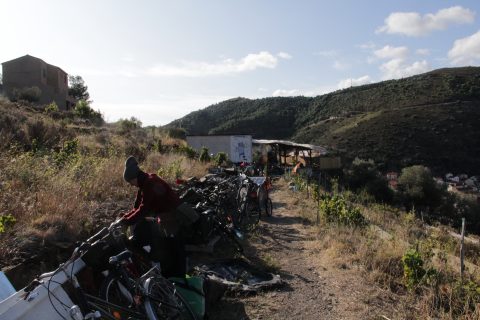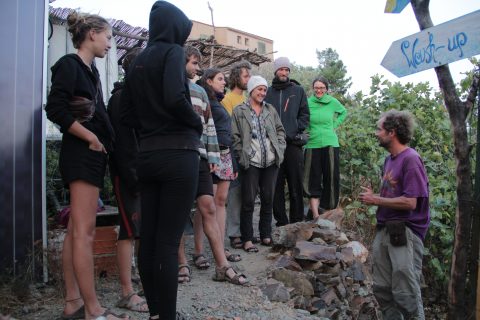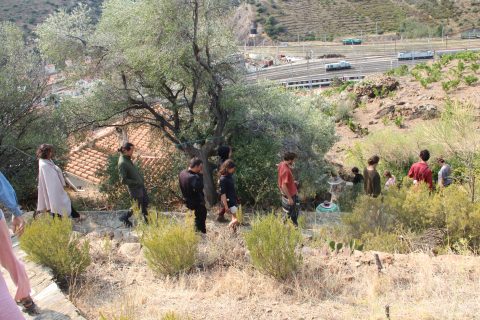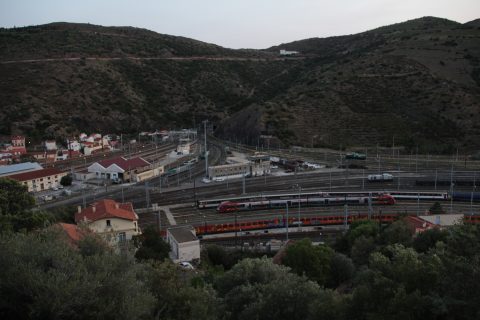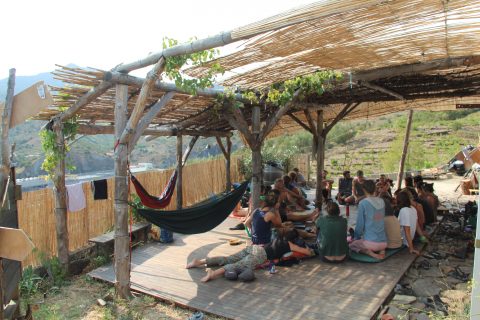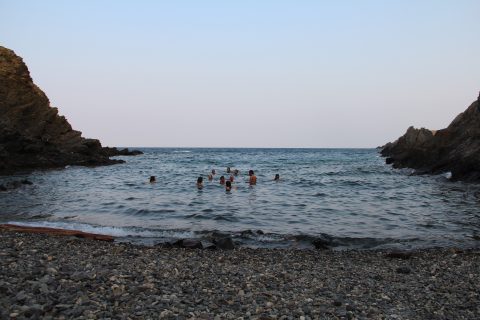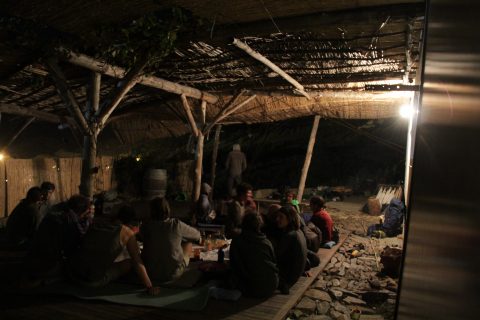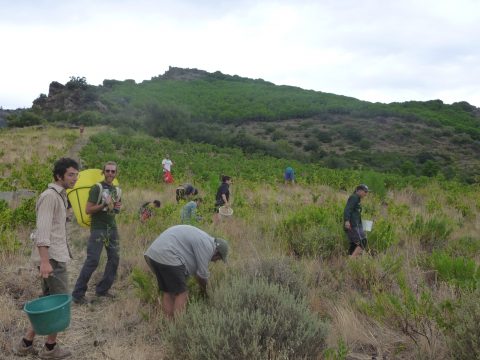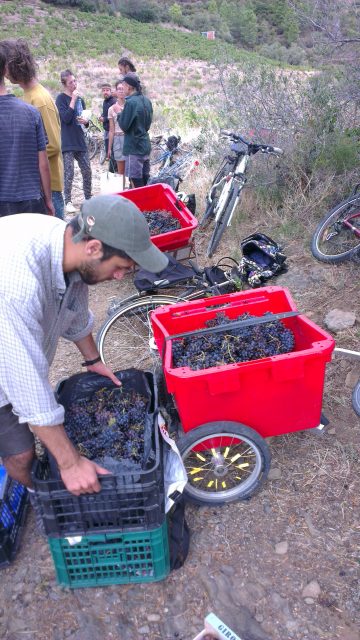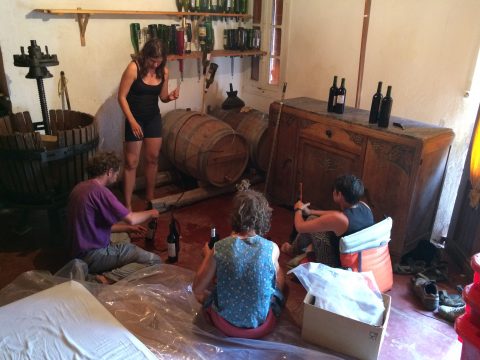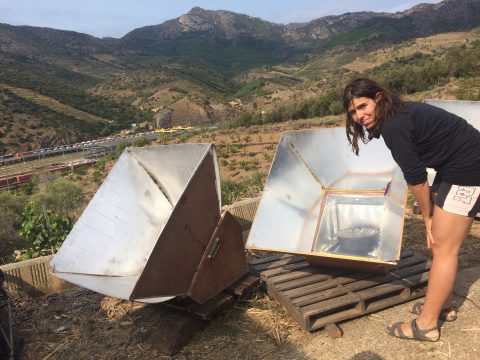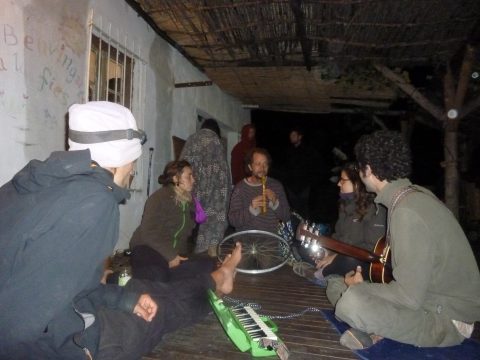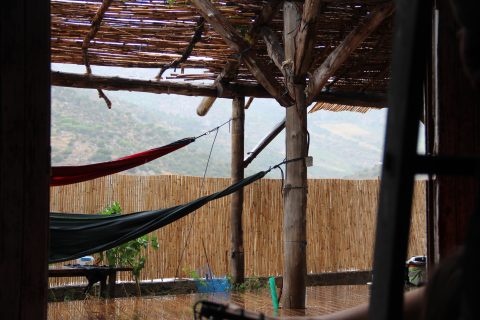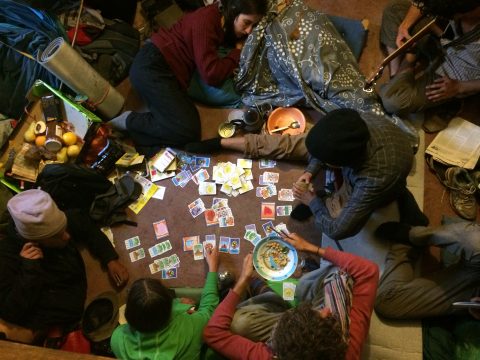We arrived at our next project, Can Decreix (Home of Degrowth), on the evening of Friday 8th. September, where we were to spend the next four nights. The project overlooked Cerbère, a small boarder town next to Catalonia, tucked away between steep vine-covered mountains, the sea and a large industrial train yard. The area is known for wine making, its dry climate and the Tramuntana, a powerful northerly wind which ravishes the area and is said to turn long-term settlers crazy.
As the name suggests, Can Decreix is a project focused on putting into practice the principals of Degrowth. This covers developing sustainable technologies, living and working together in a community, art, research and activism. The project is run by François and Crystal, supported by several WOOFERS and volunteers, as well as the wider Degrowth network. The project has hosted the Ecotopia Bike Tour before and François has participated in the Bike Tour in 1993 and 2003; he joked how he liked to do it about once every 10 years.
Day 1
On the first day we warmed up in the morning with some rock carrying exercises before François gave us a tour of the project. The tour demonstrated some of the radical ecological approaches tested by the project such as avoiding all sodium based washing products (including ecological products) and instead using ash-water and chestnut extracts; composting algarbe with urine; cooking on four beautiful solar-ovens, using bright red cactus vinegar for everything and a pedal powered washing machine. He also showed us the project office, which perhaps contains the only Degrowth library in the world, as well as the cave, where ecological-biodynamic wine in made.
Later that morning most of the group relaxed after several days on the road, whilst some people helped François bottle wine from the 2015 harvest. Wine making is the main agricultural and economic activities of the project, with a few hectares of vineyards enabling the project to produce enough wine each year to fill a 350 litre barrel. An after dinner tradition on Can Decreix, called ‘Charboa’, is to clean your plate by pouring a small drop of wine onto it and licking it off, which tastes great and saves water.
That afternoon was also had a long and heavy circle. A lot of people had left the tour since the previous circle and many more had joined, it felt like a moment of instability and transition, one person returning to the tour after a few days away said it felt like they were joining a different bike tour. The circle also included emotional discussion about oppression on the bike tour, specifically how to talk about this in the Blog and establish a process for dealing with oppression on future tours. Despite many of us finishing that circle with some frustrations and heavy hearts, by sunset many of us were dancing the ‘train on love’ together on a beautiful beach, laughing and feeling silly.
Day 2
The timing of our visit to Can Decreix could not have been better as it coincided with the annual grape harvest and wine making day. As François said, in a world dominated by industrial agriculture and machines, grape picking and wine making is one of the last remaining agricultural traditions in France which is truly sociable, involving many hands working together to produce a product which itself is enjoyed as part of other social occasions. The Can Decreix grape harvest is extra-special and fitting for the Bike Tour too, since it is done entirely using bicycles to transport the grapes along the 2km mountain track from the vineyard to the wine making cave.
We set off on our bicycles for the vineyard at 7am to avoid the midday sun and the rain forecast for later that day (wine picking is best done after a period of dry weather since rain dilutes the sugar concentration in the grapes). The convoy of 20 bikes and 4 bike trailers followed the steep winding dirty track which traversed the edge of a steep valley surrounded by mountains. On our way we passed many other families picking grapes, one of which was angry with us for having stolen some grapes from their field the previous day and shouted ‘cabron’ as we went past (in a half-jokey way!). The grape picking itself lasted for around 3 hours and by the end we had filled our trailers and panniers to the brim with a mix for black (~90%), red and white grapes, all from the Grand National family. We got the job done just before the heavens opened and by the time we had cycled back down the hill everyone was soaked.
In the afternoon it was time to clean those sweaty and smelly Ecotopia feet ready for grape squashing. The grapes (of all colours) were poured into three large buckets, each big enough for two people to squelch around in a soup of grapes, branches and juice. The soup was then poured into the 350 litre barrel which is left to ferment, then later pressed/filtered and after that matured in the barrel for around a year or two before bottling. Unlike more industrial wine making processes, which remove the grapes from their branches before squashing and add sulphates, the wine made a Can Decreix includes the branches during fermentation, which adds tannins and natural yeast to the fermentation process.
That day we also learnt about what makes red wine red wine and white wine white wine. And guess what… it’s not the colour of the grapes! White wine and red wine can be made for any colour of grape (black, red or white). What distinguishes them is the stage in the process when they as pressed/filtered. White wine is filtered before fermentation, whilst red wine is fermented first with the skins and this allows the tannins some colour to travel from the skins to the juice. But there is twist in the story, just to confuse things. Most ‘white wine’ is made from white grapes and most ‘red wine’ is made from black/red grape, but this is not what makes it a white or red wine!
Day 3
On our final day at Can Decreix people mostly did their own thing, some making grape juice (we had filled the wine barrel with still loads of grapes to spare!), some worked on the oppression topic and some of us hiked to the top of Puig de Querroig (670m). That evening we enjoyed a final beautiful meal with François, Crystal and the other amazing volunteers at the project, with more cactus vinegar and zero-kilometre zero-carbon wine.






